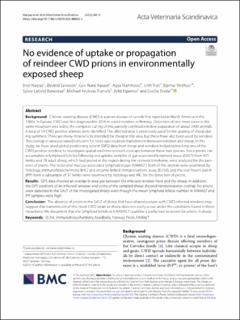| dc.description.abstract | Background Chronic wasting disease (CWD) is a prion disease of cervids first reported in North America in the 1960s. In Europe, CWD was first diagnosed in 2016 in a wild reindeer in Norway. Detection of two more cases in the same mountain area led to the complete culling of this partially confined reindeer population of about 2400 animals. A total of 19 CWD positive animals were identified. The affected area is extensively used for the grazing of sheep during summers. There are many mineral licks intended for sheep in the area, but these have also been used by reindeer. This overlap in area use raised concerns for cross-species prion transmission between reindeer and sheep. In this study, we have used global positioning system (GPS) data from sheep and reindeer, including tracking one of the CWD positive reindeer, to investigate spatial and time-relevant overlaps between these two species. Since prions can accumulate in lymphoid follicles following oral uptake, samples of gut-associated lymphoid tissue (GALT) from 425 lambs and 78 adult sheep, which had grazed in the region during the relevant timeframe, were analyzed for the presence of prions. The recto-anal mucosa associated lymphoid tissue (RAMALT) from all the animals were examined by histology, immunohistochemistry (IHC) and enzyme-linked immunosorbent assay (ELISA), and the ileal Peyer's patch (IPP) from a subsample of 37 lambs were examined by histology and IHC, for the detection of prions. Results GPS data showed an overlap in area use between the infected reindeer herd and the sheep. In addition, the GPS positions of an infected reindeer and some of the sampled sheep showed temporospatial overlap. No prions were detected in the GALT of the investigated sheep even though the mean lymphoid follicle number in RAMALT and IPP samples were high. Conclusion The absence of prions in the GALT of sheep that have shared pasture with CWD-infected reindeer, may suggest that transmission of this novel CWD strain to sheep does not easily occur under the conditions found in these mountains. We document that the lymphoid follicle rich RAMALT could be a useful tool to screen for prions in sheep. | |
